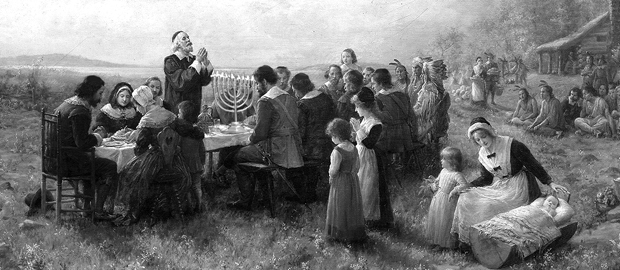Put on your yarmulke, it's time for Thanksgivukkah
Rabbi explains once-in-a-lifetime confluence of holidays

Why doesn’t Hanukkah occur on a fixed date?
The Jewish calendar is lunar-based, which means that, ironically enough, we, as Jews, live with our feet in two worlds. There’s the Gregorian calendar, which much of the world uses, and at the same time, we’re functioning on the Hebrew lunar calendar. We have either 29 or 30 days per month. As a result of being on this lunar schedule, our year shifts incrementally on the Gregorian calendar, and as the holiday moves further and further away from the season we expect it in, we have a leap month – not unlike February on the Gregorian calendar – it just comes a little less often. Leap month is this particular year. Hanukkah always begins on the 25th day of the month of Kislev.
When will the two holidays again coincide?
The Jewish calendar is on a 19-year cycle. As such, the next time the two holidays will occur together is Thursday, Nov. 28, 79811, or nearly 77,800 years from now.
What significance does the collision of this secular American and Jewish holiday have?
The connection between these holidays is fascinating. Hanukkah is already, in so very many ways, a very secularized and Americanized holiday for us. It’s not the case in other parts of the world, necessarily. Because Christmas has such a powerful social and commercial construct in this country, Hanukkah has been disproportionately elevated due to its timing, generally, near Christmas. If you look at Jewish tradition as it reflects on Jewish holidays, Hanukkah is not very important, but Jews have very often adapted to their host community.
One of the reasons why the notion of Thanksgivukkah is really taking off is that Thanksgiving is already of great significance for so many people in the Jewish community. Pilgrims come to this country because they are escaping religious persecution, so Hanukkah really resonates with Jews. It’s the only holiday where observant Jews can celebrate without any of the travel and cooking restrictions of Jewish holidays. I can’t think of a single observant Jew who doesn’t sigh at relief at being able to serve dinner right from the oven.
Also, Hanukkah is a celebration of heroism, renewal, and maintaining your identity in an environment that is trying to hold you back. Thanksgiving is in its origin points, a celebration of gratitude, of being able to survive in this new land. We can also offer gratitude for having been able to reclaim our religious rituals.
This is a powerful opportunity to acknowledge the way in which the American Jewish experience fits into American freedom and the gratitude the American Jewish community has really been able to become itself in such a strong way, under the auspices of the American culture. We can express gratitude for the bounty and have an opportunity to be grateful that we have found ourselves in a place of strength. In some ways our success has been our own detriment, that American experience makes it easier to let go of being Jewish. There’s not threat to our Judaism. We are a generation in which we are all Jews by choice. It is a mixed blessing.
In what interesting ways are people trying to combine the two holidays?
We’ve seen this Kickstarter campaign for a Menurkey – not high on my list of ways I want to decorate my table. It’s a turkey with eight spaces for candles.
I saw a recipe that’s made of stuffing, much like an Italian rice ball, with a center core of cranberry sauce that has been coated in latke, and then deep fried. Could there be any greater synergy than that?
We walk a very fine line between selling out our holiday celebrations, by going to crazy extremes to highlight the relationship between the two, and on the other side, really using it as a moment to celebrate and reflect on how fortunate we are to have this meal and this conversation. The creativity that this is generating is a sign that, in spite of the doomsday views, Jewish tradition is alive and well and kicking and growing ever more creative.
Categories: General, Humanities and Social Sciences





